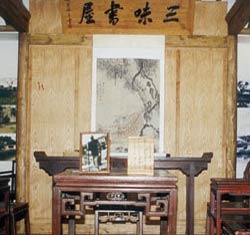
Over the course of Chinese history, Beijing has been the home of many intriguing and important figures. Along with the rapid progress of Beijing's modernization, many hutongs (back street lanes) have been rebuilt into broad roads lined with modern buildings. The former residences of some of China's most important people, however, have been well preserved, holding more value maintained than destroyed. Among these, two residences are protected by the state, and 11 fall under municipal protection. These residences once belonged to notable personages of contemporary Chinese revolution, those renowned in modern and contemporary Chinese culture, and famous historical figures.
Lu Xun was born Zhou Shuren on September 25, 1881, in Shaoxing, Zhejiang Province. Zhou adopted the pen name Lu Xun in 1918, when he began writing for New Youth magazine.
A great writer and thinker, and the founder of Chinese modern literature, Lu Xun was born into a downfallen scholar-bureaucratic family. As a child, he was educated to read poems and classic books. He often accompanied his mother on visits to his grandma, who lived in the countryside, and those experiences later became material for his novels about rural life.
In 1898, Lu went to Nanjing for study. It was there that he first learned about Western bourgeois-democratic thought and contemporary science. Four years later, influenced by evolutionist thought, he went to Japan, where he first studied medicine and later turned to writing. He believed that literature could change the spirit of a falling nation. In May 1918, Lu wrote and published A Madman's Diary, his first novel, in a modern, colloquial style. A fierce attack against the old ritualistic dogma and feudal system, this novel laid the cornerstone for modern Chinese literature. In 1921, he published a novella, The True Story of Ah Q, which is still considered a monument in the history of modern Chinese literature. His novels mostly derived from the harsh realities of the time, revealing the pains in people's lives and advocating relief for society. In addition, Lu also made great contributions in supporting and instructing advanced literary societies, taking in and training young writers, translating and introducing foreign literary and artistic works, and sorting and studying the ancient Chinese literary heritage.
Lu came to Beijing in May 1912. His first home in Beijing was in the Shaoxing Chamber in Nanbanjie Hutong, south of Xuanwu Gate. There, he wrote A Madman's Diary, Kong Yiji, and Medicine. Later, he sold his old house back in Shaoxing and used that money to purchase a house at Badaowan in Xinjiekou.
After moving into the new house at Badaowan, Lu Xun reached the peak of his literary career. He completed nine novels, including The True Story of Ah Q, Storm, Hometown, and Local Opera. It was also during this period that he published his first novel collection, Call to Arms, translated blind Russian poet V. Erosenko's A Collection of Fairy Tales, and compiled the first volume of A Concise History of Chinese Novels. That house remains, but has become an everyday residence for several local families.
In May 1924, Lu moved into the No. 21 compound at Fuchengmen's Lane 3; he lived here until he was relocated to Shanghai in 1928. It was a typical residential compound of Old Beijing, and all the houses here were designed by Lu Xun himself in the spring of 1924.
Lu named his studio, which was also his bedroom, the Green Woods Study. From the studio, he produced more than 200 acclaimed works, including the poem Wild Grass; the essay collections Hua Gai, Wandering, and Morning Flowers Picked at Dusk; and translated versions of A Concise History of Chinese Novels and Hot Wind.
Lu died in Shanghai on October 19, 1936.
On the 20th anniversary of his death, this compound was formally opened to the public as Lu's former residence. In 1979, it was designated as a cultural site under municipal protection.
Useful Information
Address: 19 Fuchengmen Gongmen Ertiao
Telephone: 86-10-6615-6549/8
Nearest buses: 719, 44, 387, 103, 102
Admission: 5 yuan
Opening hour: 9 am-3:30 pm, closed on Mondays
Please click here to see local weather
Please click here for reservation
(China Pictorial July 23, 2004)
|

